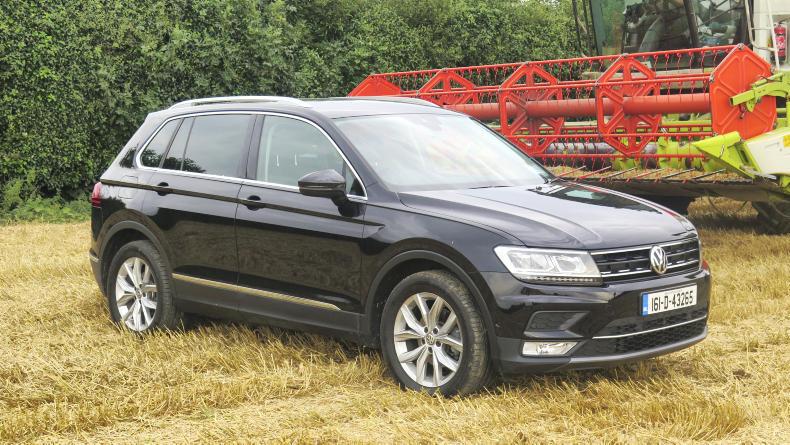Volkswagen’s new Tiguan is all about style, with sharper lines to the design. Volkswagen has sneaked a little bit of extra length into the SUV and they have also stretched the wheelbase a little. This gives that new Tiguan a good level of driving comfort without compromising the turning ability.
Add the solid feel for which Volkswagen is renowned and you’ll feel good driving this latest Tiguan. The inside is equally modern, with new-generation digital instruments that are clear to view and easy to use.
The steering wheel is very tactile and lovely to use. It is not too big either, with full controls included. The seat position was good but it took a little time to get to my comfort zone. There is good rear legroom and the high positions for all seats are appreciated, with good headroom.
The Tiguan comes with an electric handbrake as standard along with auto-hold hill start assist. The useful Park Assist system is standard on the more expensive Highline versions.
The Tiguan is available with a 1.4-litre turbo petrol engine or the 2.0-litre turbo-diesel that I had on the road. This engine has undergone some improvements in emissions (no surprise), while the engine power and torque remain virtually the same.
The Tiguan is a good match for the competition in terms of fuel economy but I was a little surprised that there is only a small improvement over the previous one. The emphasis has been on emissions and that’s now a marginally lower figure, giving lower road tax costs.
This new Tiguan matches the economy performance of the similar engine size Toyota RAV4, which is cheaper to buy and own. Volkswagen has put a smaller fuel tank into the new Tiguan, dropping six litres from its capacity to 58 litres.
The official economy figure is 21km/litre (4.7l/100km or 60mpg) and I found that across a range of rural driving conditions I was about 15% off that figure. That’s a good result in practical driving, and it’s also useful to remember that the Tiguan that I drove was a two-wheel-drive version.
In practice, I found the Tiguan to be economical. With steady driving using all six gears, it was possible to drive under 2,000rpm most of the time. That’s the magic spot when it comes to fuel economy and I found that a 1,000km range was well possible on this smaller fuel tank with sensible driving.
The six-speed gearbox makes for smooth driving and the relatively high torque rating at 340Nm allows for easy gear changes. I had no trailer towing experience with the Tiguan. It would have been useful.
The towing ability of the new Tiguan is rated at 2t for the base model and you need to add the 4Motion 4x4 system and the DSG automatic gearbox to the deal to get it up to 2.5t. The 2t towing figure is common in this SUV market segment.
The longer wheelbase has also allowed for more boot space. The Tiguan has a noticeably bigger boot, bigger than all of the competition, while it is still a five-seat vehicle. And the bonus is the fact there is a spare wheel included, even if it’s a space-saver version.
There is plenty of safety kit included, with Iso-Fix kit in the rear and the benefit of a recent five-star Euro NCAP rating. The rear seat adjustment is flexible and easy to fold. This is when the size of the boot or load area comes into its own.
There is a large screen for radio and infotainment controls that was easy to set up and use. Connecting my phone with Bluetooth was quick and easy. The test Tiguan did not come with satnav included but it is possible to use your phone to connect with Google Maps rather than opt for the more expensive factory satnav system.
I looked at the Tiguan running costs and found that relative to the likes of the Toyota RAV4, it was marginally more expensive to buy and to own, due to higher depreciation resulting from higher entry prices. The diesel entry price starts at €33,765 or £23,695 in Northern Ireland. That’s more expensive than the RAV4 and also the new competition from Volkswagen’s own stable in the shape of the Seat Ateca that was prominent at the recent Ploughing. Skoda will soon have a similar offer, so this will test Volkswagen’s determination to hold a higher price for the Tiguan.
Come away from driving the Tiguan and you’ll like the improved new look, the driving feel from behind the wheel and the overall solid feel that comes with the Volkswagen brand. Don’t expect too much in terms of economy; driving it sensibly will bring its benefits. The mid-range segment is a price-sensitive market; don’t be afraid to be brand independent and seek out your best longer-range ownership costs, PCP or not, that can be matched with the benefit of Tiguan comfort.






 This is a subscriber-only article
This is a subscriber-only article



















SHARING OPTIONS: